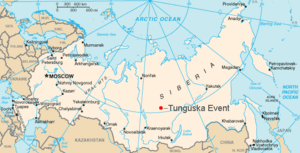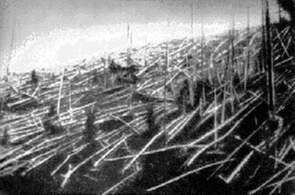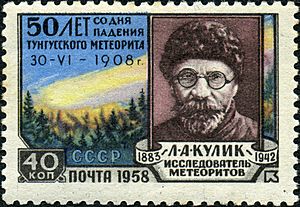Tunguska event facts for kids
Quick facts for kids Tunguska event |
|
|---|---|

Location of the event in Siberia (modern map)
|
|
| Event | Explosion in forest area (10–15 Mtons TNT) |
| Time | 30 June 1908 |
| Place | Podkamennaya Tunguska River in Siberia, Russian Empire |
| Effects | Flattening 2,000 km2 (770 sq mi) of forest |
| Damage | Mostly material damages to trees |
| Cause | Probable air burst of small asteroid or comet |
| Coordinates | 60°55′N 101°57′E / 60.917°N 101.950°E |
The Tunguska event was a huge explosion that happened high in the sky over Siberia on June 30, 1908. Many people who saw it described one or more big blasts around 7:15 a.m. local time. We don't know for sure what caused these explosions. However, many scientists think it was caused by a meteorite hitting Earth.
About 30 kilometres (19 mi) around the explosion site, trees were knocked down. In a small village called Wanwara, about 65 km (40 mi) away, windows and doors were broken. It's thought that trees were flattened over an area of about 2,000 km2 (770 sq mi). People saw a bright light and felt an earthquake more than 500 km (311 mi) away.
Luckily, no one was reported to have died. This is because very few people lived in that area at the time. Some sources mention one or two injuries.
Today, experts believe the explosion happened between 7 to 15 km (4.3 to 9.3 mi) above the ground. This was at 0:14 UTC (7:14 a.m. local time).
Contents
What Caused the Tunguska Explosion?
What happened is called an air burst. This means an object exploded in the air, not on the ground. At first, people thought the energy from the blast was like 10 to 30 megatons of TNT. This depended on how high the explosion happened.
New computer models suggest the energy was probably between 3 and 5 megatons of TNT. To give you an idea, 15 megatons is 1,000 times more powerful than the atomic bomb dropped on Hiroshima in 1945. The shock wave felt like an earthquake of magnitude 5.0 on the Richter scale. Because of this, the Tunguska event is the biggest impact event ever recorded on Earth.
Exploring the Tunguska Site
For a long time, no one paid much attention to the Tunguska event. More than ten years later, a Russian mineralogist named Leonid Kulik led an expedition. In 1921 and 1922, he only reached Kansk, which is 600 km (373 mi) from the explosion's center.
In 1927, Kulik finally reached the actual site of the event. In 1938, he arranged for aerial photos to be taken. Kulik's trip was the first recorded expedition to the area. Since then, many more expeditions have taken place. Over 1,000 articles have been written about the event, mostly in Russian.
Other important expeditions happened in 1958 and 1963.
Main Ideas About the Tunguska Event
There is still no single, definite answer for what caused the explosions. However, there are a few main ideas.
The Meteorite Theory
The most popular idea is that a meteorite hit the area. This was likely a small asteroid or comet. It probably had a low density and was between 30 metres (98 ft) and 80 metres (260 ft) wide. This object exploded high up, about 7 to 14 km above the ground. This is why there is no impact crater on the surface.
One challenge with this idea is that low-density objects like this usually break apart higher in the atmosphere. Meteoroids with more iron are more likely to reach lower levels. But they don't usually cause such huge explosions.
The Mystery of Lake Cheko
Lake Cheko is a small lake about 8 kilometres (5.0 mi) from the center of the Tunguska event. This lake doesn't appear on maps made before 1928. It seems no one knew about it before 1908. The lake is shaped like a rectangle, about 708 meters long, 364 meters wide, and 50 meters deep.
In 1999, Luca Gasperini studied the lake's bottom. He found that the lake was older than the 1908 event. However, in 2007, he suggested that the lake might have formed from an impact crater.
The Natural Gas Theory
Another idea is that the event had a natural cause from Earth itself. This theory suggests that about 10 million tons of natural gas exploded. This could create effects similar to what was seen.
However, this theory has a problem. Eyewitnesses said they saw a very bright light from far away. A natural gas explosion usually doesn't produce such a bright flash.
Images for kids
-
Comparison of possible sizes of Tunguska (TM mark) and Chelyabinsk (CM) meteoroids to the Eiffel Tower and Empire State Building
See also
 In Spanish: Bólido de Tunguska para niños
In Spanish: Bólido de Tunguska para niños






